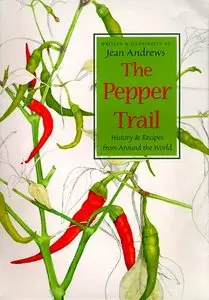Jean Andrews, "The Pepper Trail: History and Recipes from Around the World"
English | ISBN: 1574410709 | 1999 | PDF | 272 pages | 3.2 MB
English | ISBN: 1574410709 | 1999 | PDF | 272 pages | 3.2 MB
It's hard to believe that chilis, hot peppers in general, were known exclusively in South and Meso-America until Columbus brought them back to Europe. Since then, cuisines all over Europe, Africa, the mid-East, Asia, and Pacifica have adopted them, naturalized them, and incorporated them so deeply into native cuisine that chilis seem to have been there forever.
Andrews starts the book with brief descriptions, region by region, of how the peppers arrived at their new homes. Next, she gives a brief tour of the pepper zoo, talking about everything from the sweet bell peppers and pimentos to incendiary Scotch bonnets and habaneros. Instead of photos, skillful drawings represent each variety (hard to believe they're mostly the same species), clearly representing the distinctive form of each without distracting detail. After these introductions, she describes the less familiar ingredients that complement capiscum in various dishes. Although I've seen such ingredient lists before, seeing samples from such a wide sweep of cuisines gives this listing a distinctly cosmopolitan sense.
Then come the recipes themselves. In no particular order, you'll see Indian curries, Thai and Chinese specialties, Tex-Mex, South American, and more - sometimes with three nationalities represented on a single page. These include not just the things you'd expect, but new takes on favorites like vichysoisse and even brownies. Literally, everything from soup to nuts. (Although not in this book, my own kitchen produces honey-glazed walnuts with rosemary and cayenne, very good for making friends.) Andrews's thorough research shows in the thick bibliography at the end, where scientific and historical references seem to outnumber culinary sources.
If you love food, it's easy to pick up a cookbook and leaf through it, looking for the gems hidden somewhere among the recipes. But, since this provides so much historical and botanical background, even non-foodies can find something of interest, tracing how different trading and political empires expanded world-wide, bringing the oldest documented spice with them. A captivating resource, in many ways.



